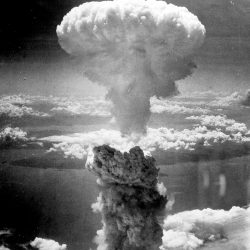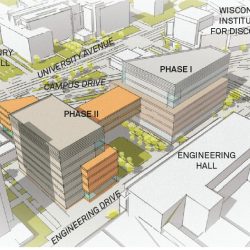Nuclear Engineering 234
Principles and Practice of Nuclear Reactor Operations

Radiation glows blue in the UW nuclear reactor. Students in NEEP 234 learn to operate the one-megawatt training reactor. Courtesy of the UW College of Engineering
The student sticks a key into the ignition. Her fuel heats up — way up, to somewhere around 570 degrees. She flips levers to shift the control blades. Then it happens.
In the next room, the water in the nuclear reactor she’s “driving” begins to glow a vibrant blue. Radiation is becoming visible, but the water itself barely shimmers, as if nothing extraordinary — such as atoms splitting apart into energy — is happening at the bottom of the thirty-foot tank.
The student isn’t especially impressed, either, as she watches the monitor. After all, it’s just another day of class.
Once every two years, sixteen nuclear engineering students take Nuclear Engineering and Engineering Physics (NEEP) 234 at the Max W. Carbon Radiation Science Center. Half of the class is reserved for first- and second-year students, and at the end of the semester, a handful of them will be invited to sit for a licensing exam proctored by the Nuclear Regulatory Commission.
Any student who passes will then be offered a job as a part-time UW reactor operator — an invaluable opportunity that has launched the careers of generations of reactor operators around the country.
Blue-glow bonding
For some students, NEEP 234 is much more than a few credits and an internship. “Everyone knew each other and had a certain sense of camaraderie in getting through this class,” says Dan Ludwig ’08, MA’08, an engineer at Xcel Energy.
“Maybe it’s something about having to be to class by 7:30 a.m. that makes you realize that you want to be around people who have the desire to learn the same things that make your own brain smile,” says Sam Maslonkowski ’12, a reactor operator at an Alabama nuclear plant.
And the sense of community doesn’t end with the semester. Most student reactor operators keep in touch with Michelle Parker Blanchard ’91, one of the three senior staff reactor operators who rotate as lead instructor. A NEEP 234 alumna herself, Blanchard says the course often helps students find their place at the UW — and their professional path.
“This class is why I ended up in reactors,” she says. “I just fell in love with it.”
Feeling like a real engineer
In addition to classroom time, every student gets to sit at the reactor control panel for up to an hour each week. These “behind-the-wheel” sessions help set the class apart from most other engineering courses.
“I think a lot of college students desire to see real-life applications for their studies, and [I] feel that I was given that opportunity,” says Maslonkowski. “It made all the difference.”
Matt DeHart ’13 worked as a student reactor operator for three years and oversaw training sessions for two NEEP 234 cohorts after him — an experience that has helped bring his knowledge of the reactor full circle.
“Training the new students each time the class is offered helps to further reinforce what I learned in the class and makes me a better engineer,” he says.
Currently, the NEEP 234 instructors are exploring options for increasing class enrollment capacity and creating new opportunities to get students in the lab.
“The course is resource intensive, but we are active in our efforts to increase the number of students who get to use the reactor,” says Blanchard. “Ideally, it [will] be available for all nuclear engineering students at some point.”
Published in the Spring 2014 issue



Comments
No comments posted yet.